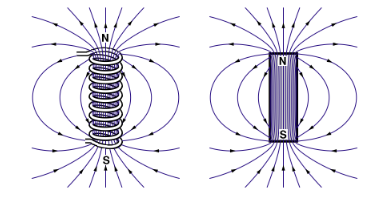
A moving charge can produce a magnetic field. Draw the magnetic field lines for a current loop to support your answer.
Answer
489k+ views
Hint: Magnetic field lines are the tool that is used to explain the magnetic field. It explains the direction of the magnetic force on the north pole at a given position.
Complete step-by-step answer:
Oersted observed that electric current through a conductor produces magnetic fields in the surrounding space. Ampere supported this observation by saying that electric charges in motion produce a magnetic field. Michael Faraday showed that moving magnets or changing magnetic fields generate electricity. Maxwell unified the laws of electricity and magnetism and developed a new field called electromagnetism. Most of the phenomenon occurring around us can be described under electromagnetism.
A static charge produces an electric field E at every point in the region around it. A charge q is placed at any point that interacts with this electric field and experiences force
Just as static charges produce an electric field, conductors carrying current or moving charges produce magnetic fields which are denoted by
Magnetic field is a region around a magnet or the space around the current carrying conductor.

Note: The properties of magnetic field lines are,
The magnetic field lines of a magnet or a current carrying conductor forms a continuous closed loop.
The direction of the magnetic field at any point be represented by drawing a tangent to the field line at a given point.
The number of magnetic field lines crossing unit area held perpendicular to the magnetic field is called magnetic flux density.
The magnetic field lines do not intersect this is because every point has a unique direction for the magnetic field.
Strongly attracted by the magnetic field the ferromagnetic can be magnetized permanently. It consists of unpaired electrons all having in the same direction.
Complete step-by-step answer:
Oersted observed that electric current through a conductor produces magnetic fields in the surrounding space. Ampere supported this observation by saying that electric charges in motion produce a magnetic field. Michael Faraday showed that moving magnets or changing magnetic fields generate electricity. Maxwell unified the laws of electricity and magnetism and developed a new field called electromagnetism. Most of the phenomenon occurring around us can be described under electromagnetism.
A static charge produces an electric field E at every point in the region around it. A charge q is placed at any point that interacts with this electric field and experiences force
Just as static charges produce an electric field, conductors carrying current or moving charges produce magnetic fields which are denoted by
Magnetic field is a region around a magnet or the space around the current carrying conductor.

Note: The properties of magnetic field lines are,
The magnetic field lines of a magnet or a current carrying conductor forms a continuous closed loop.
The direction of the magnetic field at any point be represented by drawing a tangent to the field line at a given point.
The number of magnetic field lines crossing unit area held perpendicular to the magnetic field is called magnetic flux density.
The magnetic field lines do not intersect this is because every point has a unique direction for the magnetic field.
Strongly attracted by the magnetic field the ferromagnetic can be magnetized permanently. It consists of unpaired electrons all having in the same direction.
Latest Vedantu courses for you
Grade 8 | CBSE | SCHOOL | English
Vedantu 8 CBSE Pro Course - (2025-26)
School Full course for CBSE students
₹45,300 per year
Recently Updated Pages
Master Class 11 Economics: Engaging Questions & Answers for Success

Master Class 11 Business Studies: Engaging Questions & Answers for Success

Master Class 11 Accountancy: Engaging Questions & Answers for Success

Master Class 11 English: Engaging Questions & Answers for Success

Master Class 11 Computer Science: Engaging Questions & Answers for Success

Master Class 11 Maths: Engaging Questions & Answers for Success

Trending doubts
State and prove Bernoullis theorem class 11 physics CBSE

1 ton equals to A 100 kg B 1000 kg C 10 kg D 10000 class 11 physics CBSE

State the laws of reflection of light

One Metric ton is equal to kg A 10000 B 1000 C 100 class 11 physics CBSE

Difference Between Prokaryotic Cells and Eukaryotic Cells

1 Quintal is equal to a 110 kg b 10 kg c 100kg d 1000 class 11 physics CBSE




